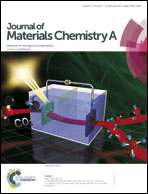Improved reversible dehydrogenation of 2LiBH4–MgH2 composite by the controlled formation of transition metal boride
Abstract
In this paper, we report a careful study of the properties and mechanisms of a 2LiBH4–MgH2 composite with a niobium oxide (Nb2O5) additive. It was found that directly milling with a small amount of the Nb2O5 additive exerted a negligible effect on the dehydrogenation kinetics of the 2LiBH4–MgH2 composite in the first cycle. However the recycled sample showed notable property advantages over the neat 2LiBH4–MgH2 composite. Phase/chemical state analyses and control experiments were conducted to gain insight into the chemical transformation of the Nb-containing species. It was found that the Nb2O5 additive reacted with LiBH4 to form a niobium boride (NbB2) heterogeneous nucleation agent, via a niobium hydride (NbH2) intermediate, in the dehydrogenation process of the composite sample. The retarded formation of the NbB2 is a major mechanistic reason for the observed drastic property change of the composite upon cycling. As a solution, we employed a novel three-step method to controllably promote the formation of the targeted NbB2 species and improve its dispersion state. As expected, the 2LiBH4–MgH2–0.08Nb2O5 composite sample, prepared using the new method, exhibits rapid dehydrogenation kinetics and high cyclic stability, which compare favorably with the literature results of the 2LiBH4–MgH2 composites with transition metal additives.


 Please wait while we load your content...
Please wait while we load your content...